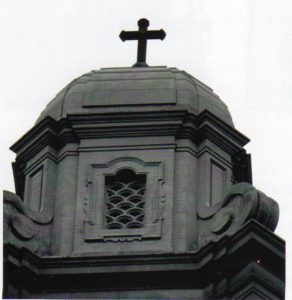Spanish Renaissance Choice for Saint Cecilia Cathedral
 In 1907 when the cornerstone of Saint Cecilia Cathedral was laid, architecture in the Spanish style was not among the American vogue of then popular European-inspired revivalist traditions. In fact it was not until the 1915 Panama-California Exposition in San Diego that the stage was set for this revival, know as "Spanish Colonial," to take off in popularity in parts of the southwestern United States. Kimball's proposal to design and build in the Spanish style was therefore nearly a decade ahead of his time.
In 1907 when the cornerstone of Saint Cecilia Cathedral was laid, architecture in the Spanish style was not among the American vogue of then popular European-inspired revivalist traditions. In fact it was not until the 1915 Panama-California Exposition in San Diego that the stage was set for this revival, know as "Spanish Colonial," to take off in popularity in parts of the southwestern United States. Kimball's proposal to design and build in the Spanish style was therefore nearly a decade ahead of his time.
The prevailing taste in ecclesiastical architecture across America for all Christian denominations was for the Gothic Revival. This was true at the local level as well as among the Protestant church constructed at the turn of the century in Omaha that were either Gothic or English Georgian in style. Roman Catholic churches of this era were typically modeled after those in the French Gothic tradition or following Italian Baroque conventions. Spanish architecture had not figured among the accepted repertoire of eclectic sources for Beaux-Arts trained architects. Kimball nevertheless was successful in appropriating his classical training and taking the bold step to design Saint Cecilia in what was a radical departure from the norm. His proposal for a Spanish Renaissance-style cathedral was entirely unique making Kimball the architectural trendsetter of the Great Plains, if not the entire United States. It was thus also a prim opportunity for the Catholic Diocese of Omaha to be at the forefront in making a symbolic statement about its primacy amongst Christian denominations.
The Spanish Colonial architectural style had, of course, existed for some three centuries, first originating with the Spanish Conquest of the New World in 1521. Conquered territory that eventually was to include Mexico, Central America, the Caribbean, much of the southwestern United States, and as far north as Nebraska became known as New Spain. Churches in the Spanish Colonial period were built across much of this frontier territory to meet the needs of the missionary communities there, and each reflects some regional variation as well as a blending with native artistic traditions. Initially the Franciscans built missions throughout the Spanish American borderlands, with New Mexico's settlement being the earliest, aside from a Jesuit missionary field in southern Arizona. The production of art and architecture in service of the Catholic Church flourished until the early nineteenth century when the Spanish Colonial period finally came to an end.
It is no great leap of the imagination to see why the Spanish style seemed so appropriate symbolically for Omaha's cathedral given it was once part of the Spanish viceroyalty. Unfortunately for Kimball, he did not receive unanimous praise for his innovative design when the proposal was first made. On the contrary, in fact, the proposed idea was met with resistance. Kimball stood his ground, however; eventually winning over Bishop Scannell by arguing that his idea was the best for the diocese for several compelling reasons. On a practical note, the relative austerity of the Spanish Renaissance style enabled a tight budget to be kept without having to sacrifice dramatic impact or scale, a favorable argument for even the most verdant critic. The proposal was also appropriate for aesthetic and historical reasons given Nebraska's earliest history under Spanish and hence Catholic domain. The first non-indigenous people to enter Nebraska were in fact the Spanish. In 1541 the Spanish explorer Coronado, along with his companion Padre Juan de Padilla, traveled as far north as the southern plains looking for the mythical "lost kingdom" of Quivera that was said to have gold. In 1821 the Sante Fe Trail was established at Westport, only 200 miles south of Omaha. Less than fifty years later Omaha was also forever united to the Pacific Coast via the national railroad line once the "Golden Spike" was driven in. Circa 1900, many of Omaha's burgeoning immigrant European population were Hispanic. This the Cathedral would prove an unmistakable symbol of the gateway to the American West that Nebraska represent. Only following months of debate, however, was the plan finally approved in May of 1904.
In his work toward Saint Cecilia Cathedral, there is good reason to believe that Kimball was musing not so much over precursors in the Spanish New World alone, but that he looked back historically to Spain where the tradition began. Indeed, Kimball was apparently quite aware of his American innovation calling the Cathedral,
"...a Spanish interpretation of the Renaissance is the best way to describe it. The Cathedral is one of the first, if not the first, to be built in the United States strictly following Old Country conventions."
~Beauty of Thy House, 2005
